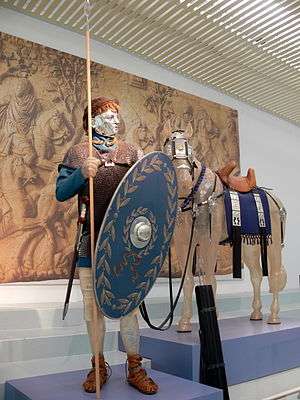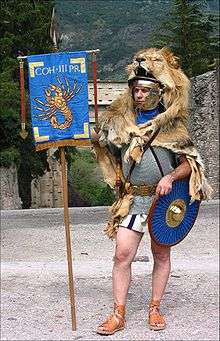Parma (shield)
 | ||||
| Part of a series on the | ||||
| Military of ancient Rome | ||||
|---|---|---|---|---|
| Structural history | ||||
|
||||
| Campaign history | ||||
| Technological history | ||||
|
||||
| Political history | ||||
|
|
||||
| Strategy and tactics | ||||
|
||||
|
| ||||
Parma or parmula (the diminutive of parma) was a type of round shield used by the Roman army, especially during the later period of Imperial history.
Characteristics
The Parma was about 36 inches (91 cm) across (or less) and had iron in its frame, making it a very effective piece of armor. Parma had a handle and a shield boss (umbo).
The Parma was used by legionnaires in the Early Republican period of Rome's history by the lowest class division of the army— the Velites. The Velites armor consisted of a parma, javelin, sword and helmet. Later, the parma was replaced by the body length scutum.
War use
It was used mainly by auxiliary infantry and cavalry, the legionaries preferring the heavier but more protective scutum, during earlier periods. It was used also by signifers (standard bearers).
In Virgil's Aeneid, the parma is cited as a weapon utilised by the Teucrians in defence against the Greeks (Battle of Troy), and later against the Rutulians.
Other uses
The parmula was the shield used by thraex gladiators. It was also used by the Roman vexillifers or flag bearers that carried the standard that marked the cohort, as well as by most early auxiliaries.
In the Pyrrhic dance it was raised above the head and struck with a sword so as to emit a loud ringing noise.
External links
- Parma (Smith's Dictionary of Greek and Roman Antiquities at LacusCurtius)

